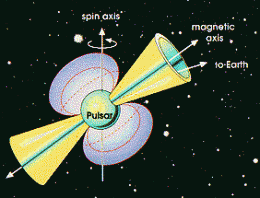August 27, 2012 report
Researchers find absorption features in spectrum of ordinary pulsar

(Phys.org)—An international team of astronomers and astrophysicists has found some unusual spectral activity involving an otherwise "normal" pulsar; it displayed some absorption lines, which generally only occurs with bodies that have some degree of an atmosphere. In studying stars that lay outside the normal galactic plane, the team found, as they describe in their paper published in the journal Science, spectra that was not as smooth as expected, along with absorption lines.
Pulsars are the remnants of stars that have exploded, leaving behind their inner core; neutron stars with a very dense mass that spins causing the electromagnetic radiation emitted to appear to flash or pulse to observers here on Earth. Researchers studying neutron stars over the years have come to define most such pulsars as "normal", i.e. they exhibit a smooth spectra. A few anomalous neutron stars been found however, that exhibit odd spectra. They exhibit weak pulsar effects and in some cases a less than strong magnetic field.
In this new find, the researchers have found a pulsar, PSR J1740+1000, that appears to exhibit behavior found in both normal and non-normal neutron starts, opening up the possibility of a third class. In every other respect, the pulsar looks like most other pulsars, the only exception being the absorption lines. And now that they've seen it, the researchers aren't sure what exactly to make of it.
One possibility is that most pulsars have absorption lines and we just can't seem them. That would be because most pulsars we can see exist in the flat, pancake like part of the galaxy known as the galactic plane. PSR J1740+1000 exists just above that plane, meaning there is less gas and dust between us and it, giving us a clearer view.
Another possibility is that the absorption occurs due to some unknown particles that might exist high up in the pulsar's magnetosphere, akin to Earth's van Allen radiation belt.
Whatever the cause, the finding has sparked some excitement in the astronomy world as it appears that there is more to pulsars than has been thought, and in further exploring pulsars and absorption properties, it's likely researchers will come to better understand anomalous features found in other stars and systems as well.
More information: Absorption Features in the X-ray Spectrum of an Ordinary Radio Pulsar, Science 24 August 2012: Vol. 337 no. 6097 pp. 946-949. DOI: 10.1126/science.1221378
ABSTRACT
The vast majority of known nonaccreting neutron stars (NSs) are rotation-powered radio and/or γ-ray pulsars. So far, their multiwavelength spectra have all been described satisfactorily by thermal and nonthermal continuum models, with no spectral lines. Spectral features have, however, been found in a handful of exotic NSs and were thought to be a manifestation of their unique traits. Here, we report the detection of absorption features in the x-ray spectrum of an ordinary rotation-powered radio pulsar, J1740+1000. Our findings bridge the gap between the spectra of pulsars and other, more exotic, NSs, suggesting that the features are more common in the NS spectra than they have been thought so far.
Journal information: Science
© 2012 Phys.org



















